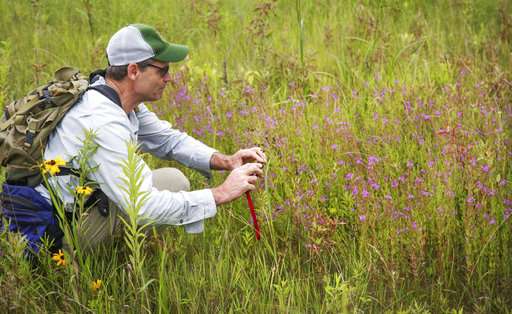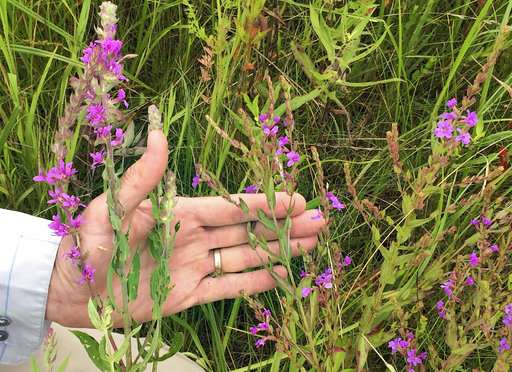In this Friday, July 14, 2017 photo released by the Vermont Fish & Wildlife Department, state botanist Everett Marshall documents the extent of winged loosestrife at Raven Ridge Natural Area in Monkton, Vt., for the state's Natural Heritage Inventory. Winged loosestrife is making a comeback in Vermont where it had not been seen for decades and was thought to be locally extinct. (Tom Rogers/Vermont Fish & Wildlife Department via AP)
Botanists in Vermont say a flowering plant long thought to be extinct in the state is making a comeback.
Botanist Everett Marshall was hiking with his wife, Deb Parrella, in the Raven Ridge Natural Area in Monkton recently. She saw the small purple flowers of the native winged loosestrife while crossing a boardwalk through a wet meadow. A guidebook confirmed the identification.
The state says a small number of winged loosestrife plants were last observed by a botanist in Middlebury in 1979. Before that, there were only eight records of the plant in Vermont, the most recent in 1933.
The winged loosestrife is closely related to purple loosestrife, which is native to Europe and Asia and is invasive in Vermont.
The 365-acre Raven Ridge is owned by The Nature Conservancy.
In this Friday, July 14, 2017 photo released by the Vermont Fish & Wildlife Department, botanist Everett Marshall compares the delicate winged loosestrife, right, to the more robust purple loosestrife, left, at Raven Ridge Natural Area in Monkton, Vt. Winged loosestrife is making a comeback in Vermont where it had not been seen for decades and was thought to be locally extinct. (Tom Rogers/Vermont Fish & Wildlife Department via AP)
© 2017 The Associated Press. All rights reserved.
























